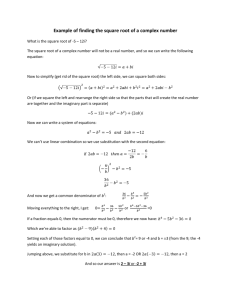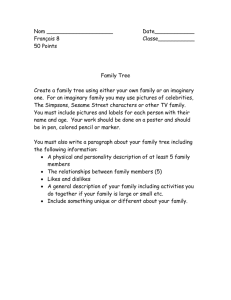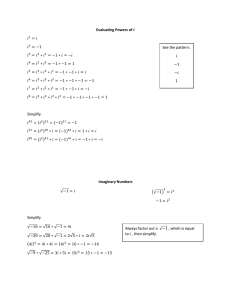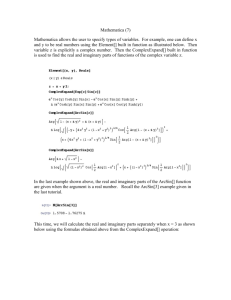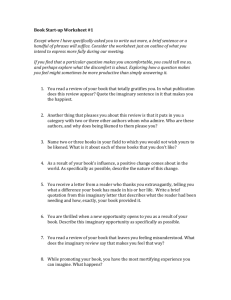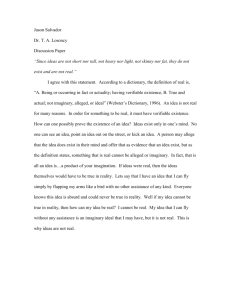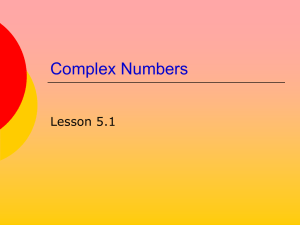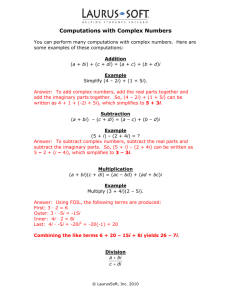M098 Carson Elementary and Intermediate Algebra 3e Section 10.7 Objectives
advertisement
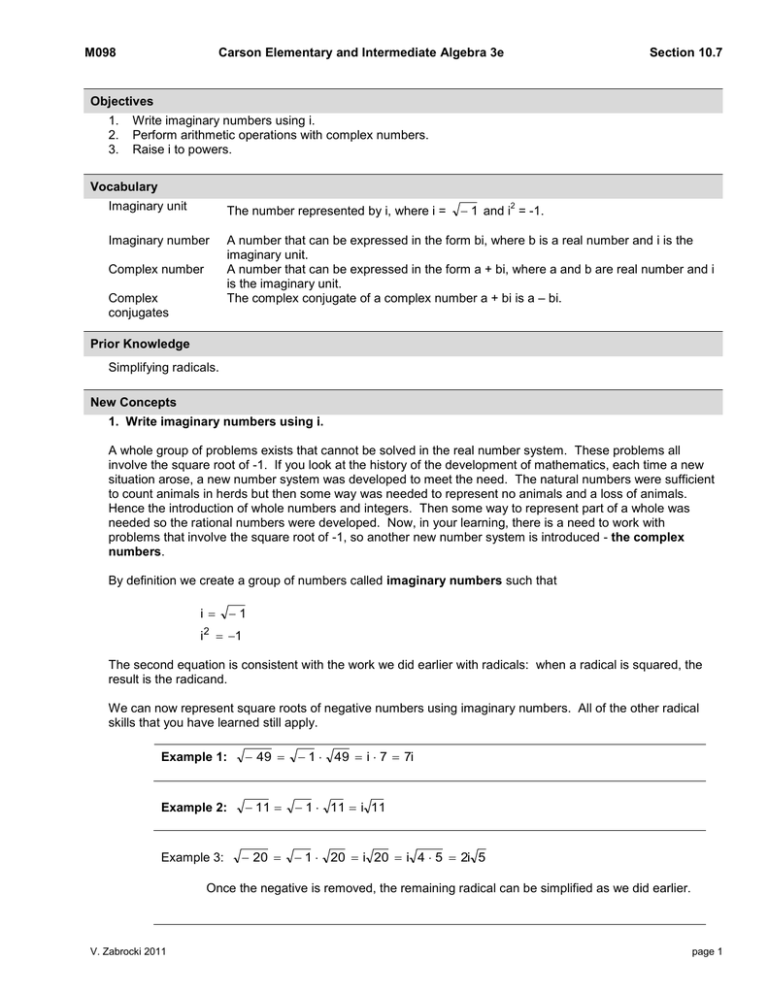
M098 Carson Elementary and Intermediate Algebra 3e Section 10.7 Objectives 1. 2. 3. Write imaginary numbers using i. Perform arithmetic operations with complex numbers. Raise i to powers. Vocabulary Imaginary unit The number represented by i, where i = Imaginary number A number that can be expressed in the form bi, where b is a real number and i is the imaginary unit. A number that can be expressed in the form a + bi, where a and b are real number and i is the imaginary unit. The complex conjugate of a complex number a + bi is a – bi. Complex number Complex conjugates 1 and i = -1. 2 Prior Knowledge Simplifying radicals. New Concepts 1. Write imaginary numbers using i. A whole group of problems exists that cannot be solved in the real number system. These problems all involve the square root of -1. If you look at the history of the development of mathematics, each time a new situation arose, a new number system was developed to meet the need. The natural numbers were sufficient to count animals in herds but then some way was needed to represent no animals and a loss of animals. Hence the introduction of whole numbers and integers. Then some way to represent part of a whole was needed so the rational numbers were developed. Now, in your learning, there is a need to work with problems that involve the square root of -1, so another new number system is introduced - the complex numbers. By definition we create a group of numbers called imaginary numbers such that i i 2 1 1 The second equation is consistent with the work we did earlier with radicals: when a radical is squared, the result is the radicand. We can now represent square roots of negative numbers using imaginary numbers. All of the other radical skills that you have learned still apply. Example 1: 49 1 49 i 7 7i Example 2: 11 1 11 i 11 Example 3: 20 1 20 i 20 i 4 5 2i 5 Once the negative is removed, the remaining radical can be simplified as we did earlier. V. Zabrocki 2011 page 1 M098 Carson Elementary and Intermediate Algebra 3e Section 10.7 2. Perform arithmetic operations with complex numbers. When the real numbers and the imaginary numbers are combined, they form the complex number system. Complex numbers are written in the form a + bi, where a is the real part and bi is the imaginary part. All of the real numbers that we are familiar with are complex numbers, but because b = 0, we don't write the imaginary part of the number. 4 is really 4 + 0i . The imaginary numbers are complex numbers where the real part is equal to 0. The earlier problem that we did with to 0. 49 7i is technically 0 + 7i. Again, we generally do not write the real part if it is equal The chart on p. 850 is a good visual representation of the system of complex numbers and how the number types are related. Just as we learned to add, subtract, multiply and divide each of the other number types, we now learn to add, subtract, multiply and divide complex numbers. As you work with these, remember that i not -1. They are not the same thing. 1 All of the operations should look familiar. The i is treated the same way a variable is treated. You will add/subtract like terms (i), multiply by foiling and divide by rationalizing the denominator. Same skills, just 2 new numbers. Remember whenever you have i , replace it with -1. (5 – 3i) + (4 – 5i) Example 4: (5 + 4) + (-3i – 5i) Combine the real parts and the imaginary parts. 9 – 8i Always write the real part and then the imaginary part. (8 – 3i) – (-1 – 2i) Example 5: 8 – 3i + 1 + 2i Rewrite as an addition problem. 9–i Combine the real parts and the imaginary parts. Example 6: (4i)(-7i) 2 -28 i Multiply (-28)(-1) Replace i with -1 2 28 Example 7: -7i(5 – 8i) 2 -35i + 56 i Multiply -35i + (56)(-1) Replace i with -1 2 -35i – 56 -56 – 35i V. Zabrocki 2011 Write in standard a + bi form. page 2 M098 Carson Elementary and Intermediate Algebra 3e Example 8: Section 10.7 (5 – 2i) (4 + i) 2 20 + 5i – 8i – 2i Foil 20 + 5i – 8i – 2(-1) Replace i with -1 2 20 + 5i – 8i + 2 22 – 3i Example 9: Combine like terms and write in standard a + bi form. (5 – 3i) 2 (5 – 3i)(5 – 3i) 2 25 – 30i + 9i Rewrite and foil. 25 – 30i + 9(-1) Replace i with -1 2 25 – 30i – 9 16 – 30i Example 10: Combine like terms and write in standard a + bi form. 6 7i Rationalize the denominator. 6 i 7i i 6i 7i 2 2 6i 7 1 Replace i with -1 6i 6i 6i 7 7 7 Rewrite with the negative in front of the fraction or in the numerator. Example 11: 5 6i 6 i 5 6 i 6 i Rationalize the denominator. 30 5i 36 i 2 V. Zabrocki 2011 2 30 5i 30 5i 36 1 37 Replace i with -1 30 5 i 37 37 Rewrite in standard a + bi form. page 3 M098 Carson Elementary and Intermediate Algebra 3e Section 10.7 3. Raise i to powers. Raising i to various powers leads to an interesting pattern: i =i i=1i=i 5 i 2 4 i = -1 i = i i = (1)(-1) = -1 i = i i = -1 i = -i i = i i i = (1)(-1)i = -i i = i i = (-1)(-1) = 1 i =i i =11=1 3 4 6 2 2 2 7 8 4 4 4 2 2 4 A power of i can always be simplified to i, -1, -i or 1. Any power of i that is a multiple of 4 will simplify to 1. 41 Example 12: 4 10 (i ) i i The largest multiply of 4 less than 41 is 40. 4 1 i 10 i =1 i 52 Example 13: i 4 13 The largest multiply of 4 less than or equal to 52 is 52. 13 i =1 (i ) 4 1 1 i 45 Example 14: 1 i 45 The largest multiply of 4 less than 45 is 44. 1 i 4 11 4 1 i i =1 1 i i i Rationalize and simplify. i i V. Zabrocki 2011 i 2 i i 1 page 4
